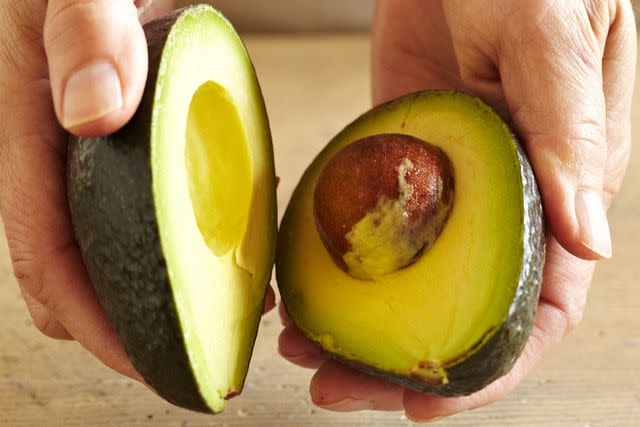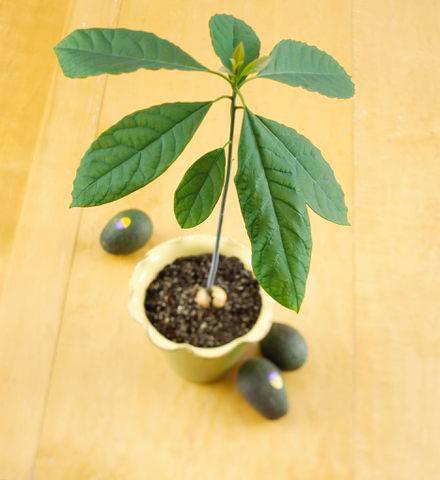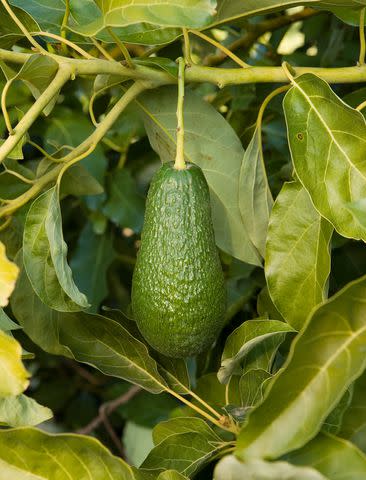How to Grow an Avocado Tree from a Pit

Learn how to grow your own avocado tree from the pit in the center of the fruit.
Reviewed by Sylvia Duax
If you're a frequent avocado buyer at the grocery store, you might've thought before about planting your own tree to harvest the fruit fresh. While it takes a lot of patience to grow an avocado tree (it can be a minimum of five years before it starts producing fruit), you'll have everything you need to get one started the next time you cut open an avocado. Here's how to grow your own avocado tree, starting with the big brown seed from the center of the fruit. You can grow the plant indoors, or outside if you live in one of the warmest parts of the U.S.

Jason Donnelly
Steps for Sprouting an Avocado Pit
It's easy to sprout an avocado seed, as you may have learned in childhood. Buy an avocado, enjoy the luscious green flesh, and wash off the seed. Remember which end of the seed was at the top and which was toward the bottom of the fruit (usually the top end of the seed is slightly tapered, and the bottom is slightly flatter). Then follow these simple steps.
1. Stick toothpicks into the avocado seed.
Poke a toothpick in the center of the seed, about where the equator would be on a globe, piercing just about ? to ? inch into the seed. Then poke two to three more toothpicks into the seed so the toothpicks are equally distributed.
2. Place the seed over water.
Place the avocado seed, bottom-end down, over a jar or glass filled with water, held in place by the toothpicks. Fill the jar with water so that about an inch of the seed is submerged. Leave the top end of the seed open to the air. Place the glass somewhere warm but away from direct sunlight, adding water so there's always about 1 inch of water covering the bottom end of the seed. Every four or five days, completely change the water in the jar to reduce bacteria that may be growing.
Tips
If the toothpicks wobble and don't hold the seed up, just stick them a little farther into the seed.
3. Let roots to grow.
Roots will grow first from the bottom of the seed, followed by a slender green shoot that should emerge from the top of the seed in about eight weeks. If nothing happens after eight weeks, begin again with another seed. (Did you really put the right end into the water?)
4. Cut the stem back.
When the seedling reaches 6 or 7 inches tall, cut the stem in half, or about 3 inches tall. This may seem counterproductive to actually growing a tree, but it helps the plant put its energy into new growth.
5. Plant the seedling in soil.
When the seedling has several leaves and thick roots, plant the seed in potting soil in a 10-inch-wide pot that has drainage holes. Leave the top half of the seed exposed above the soil line. Water the soil until water runs out of the bottom of the pot.
Related: The 13 Best Potting Soils for Indoor and Outdoor Plants

Marty Baldwin
Avocado Tree Care Tips
Light
Place your potted avocado seedling in a sunny window indoors, or move it outside any time when the temperature is 50°F or warmer. Outdoors, make sure to keep young potted avocado trees in partial shade; the leaves can burn if they get too much direct sun while they're still getting established.
Soil and Water
Check moisture levels by placing a finger into the pot's soil up to your first knuckle. Water deeply whenever the soil feels dry to the touch. Water more frequently when the plant is kept outside in warm, dry weather.
Tips
Don't let the pot sit in a saucer of water; too much water can rot the roots and cause the leaves to turn yellow.
If you are planting your tree outdoors in the ground, choose well-draining garden soil and water the newly planted avocado tree every 5 to 10 days with several gallons of water. It's better to water deeply less often to force the roots to grow to reach the water. Keeping about 6 inches away from the tree trunk, mulch with about 3 to 6 inches of coarse bark or cocoa bean hulls to retain moisture.
Temperature and Humidity
Avocado trees perform best in temperatures between 60°F to 85°F in areas with medium or high humidity. You can grow the tree outside if you live in one of the warmest parts of the U.S. Avocados grow in Hardiness Zones 8-11, and are only able to survive outdoors in southern parts of Florida or California, and in Hawaii.
Fertilizer
In summer, fertilize weekly with a fertilizer with nitrogen, indicated by a higher first number, such as 7-4-2. Avocados also need a small amount of zinc, so look for a fertilizer with that component. Avoid fertilizing during the winter when growth is minimal.
Pruning
Prune the tree regularly. Every time it grows another 6 inches tall, cut back the top two sets of leaves. When the plant reaches 12 inches, cut it back to 6 inches. When it reaches 18 inches, cut it back to 12 inches, and so forth. This encourages bushier growth.
Repotting
When your avocado tree outgrows its pot, gently remove it and place it in successively larger containers, going up in diameter two inches at a time. Use fresh potting mix when repotting.

Frequently Asked Questions
How big does an avocado tree get?
Mature avocado trees planted outside reach 15 to 35 feet tall. When grown indoors, these trees will stay smaller, especially with regular pruning.
How soon will I have avocados to harvest?
If you begin with the avocado pit in a glass of water, it can take about 13 years for the tree to bear fruit. However, if you start with a healthy, nursery-grown plant, you could be eating your own avocados in about four years.
How long do avocado trees live?
When the tree is planted in optimal conditions, it could outlive you. Avocado trees have been known to live for hundreds of years.
For more Better Homes & Gardens news, make sure to sign up for our newsletter!
Read the original article on Better Homes & Gardens.